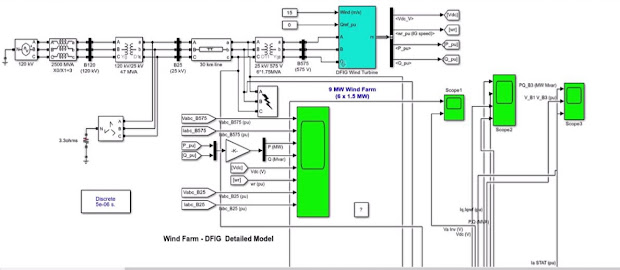The
wind farm integrated with grid system using the STATCOM based compensation
scheme, for the power quality improvements for faults i.e L-G, L-L-G, etc. The
fault given in the above model is double line to ground fault. The operation of this STATCOM control scheme is
developed with MATLAB/SIMULINK R2018a
(9.4.0.813654), 64-bit, Feb 23,2018 for maintaining the power quality. The
STATCOM compensates for the voltage fluctuations by reactive power compensation. It
maintains the voltage and support the reactive power during the demand for the wind
generator and load at PCC in the wind grid system, thus it enhances the
utilization factor of the transmission line also. The integrated wind generation
and FACTS device have shown
with the outstanding
performance. Thus the
proposed scheme in
the wind grid-connected system fulfills the power
quality norms as per the IEC standard 61400-21.
- It automatically switches ON lights when the sunlight goes below in the visible region of our eyes. (e.g.in evening after Sunset).
- It automatically switches OFF lights when Sunlight fall on it (i.e.on LDR) e.g. in mourning, by using a sensor called LDR (Light
- Dependent Resistor) which senses the light just like our eyes.
- By using this Automatic system for street light controlling, we can reduce energy consumption because the manually operated street lights are not switched off properly even the sunlight comes and also not switched on earlier before sunset.
- In sunny and rainy days, ON and OFF time differ noticeably which is one of the major dis-advantage of using timer circuits or manual operation for switching the street light system.
- LDR Light Dependent Resistor
- Take 2 transistors (N-P-N transistor-BC-547 or BC 147 or BC 548)
- Resistor-1K, 330 Ohm, 470 ohm
- Light emitting diode (LED)–Any color
- Connecting wires-Use single-core plastic-coated wire of 0.6 mm diameter (the standard size)- you can use wire that is used for computer networking.
- Power supply- 6V or 9V
- Insert first transistor Q1-BC 547(N-P-N) on board (or general PCB)as shown in the circuit diagram 1.
- Connect another transistor Q2-BC 547(N-P-N) on board as in step1.
- Connect wires across emitter pin of both transistors and –ve terminal of battery (lowest/bottom row of board.)
- Connect a wire across collector pin of transistor Q1 and Base pin of transistor Q2.
- Connect a resistor of 1 k across positive terminal of battery (top most row of board) and collector pin of transistor Q1.
- Connect Light Dependent Resistor (LDR) across positive terminal of battery (top most row of board) and base terminal of transistor Q1.
- Insert a resistor-330 Ohm across base pin of transistor Q1 and negative terminal of battery (lowest bottom row of board).
- Connect a resistor 330R across positive terminal of battery (top mostrow of board) and anode terminal of LED (Light emitting diode) & Connect the cathode terminal of LED to Collector pin of transistor Q2.
- The simple circuit is ready for testing now. Connect 6V battery terminals to the circuit as shown in fig and see the output. As you block light falling on Light dependent resistor (LDR), the LED glows.
- LED GLOWS EVEN IN LESS DARKNESS.Use torch light or Lighter if the LED glows in less darkness in addition,you can try to adjust the sensitivity of this circuit by using a variable resistor in place of R1- 300Ohm. Try this circuit with other resistances as well, (e.g.,1 KΩ,10 KΩ and 100 KΩ etc)




